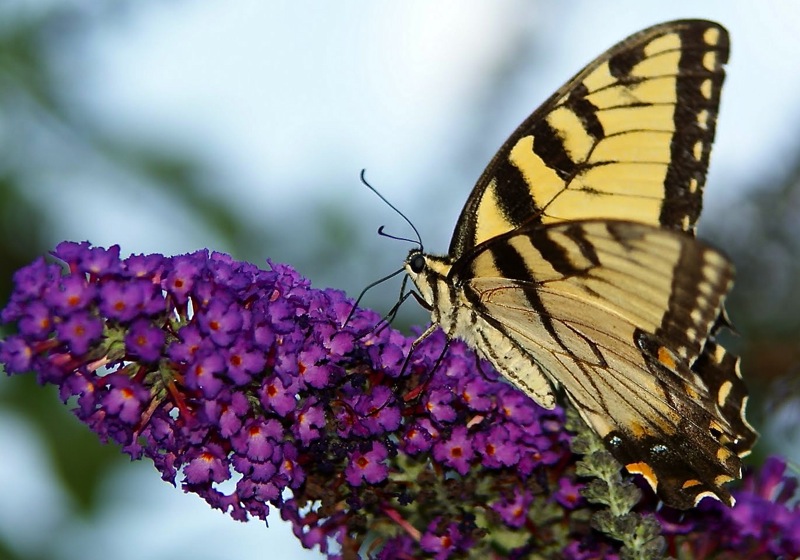I have always liked Buddleia, commonly called butterfly bush and summer lilac.  Buddleia 'Lochinch'These fast growing deciduous shrubs produce fragrant panicles of flowers in shades of purple, pink, white and even yellow from summer into fall. They attract pollinators and look great in flower arrangements. What's not to like?
Buddleia 'Lochinch'These fast growing deciduous shrubs produce fragrant panicles of flowers in shades of purple, pink, white and even yellow from summer into fall. They attract pollinators and look great in flower arrangements. What's not to like?
First, in some parts of the country the commonly grown butterfly bush, Buddleia davidii, is invasive; in some areas it is banned from sale entirely. Fortunately, some smaller cultivars, such as the Lo and Behold series that includes the Blue Chip butterfly bush, are sterile. These compact butterfly bushes grow to about 3 feet and are a good solution for smaller spaces. If one is looking for a larger butterfly bush, there are some low-fertility species available, including Buddleia weyeriana, Buddleia nivea and Buddleia fallowiana. In areas where invasiveness is a concern, it is always best to remove flowers before they go to seed.
One also needs to know that while these non-natives may provide nectar for adult butterflies, they are not a source of food for butterfly larvae; so if one wants to create a sanctuary for butterflies, there must be additional plants to host caterpillars.
I am currently growing Flutterby Petite Tutti Fruiti.

This is another sterile cultivar that will reach to about three feet. It has delightful pink blooms that come in flushes from early summer till frost. I have planted Rue (Ruta graveolens) nearby to serve as a caterpillar host plant for the Swallowtail butterflies that are common in my area. Some other host plants in my garden include Aster, Black-Eyed Susan (Rudbeckia), Coneflower (Echinacea), Violet (Viola), False Indigo (Baptisia), Dogwood (Cornus), and Sweet Bay Magnolia (Magnolia Virginiana). I must also mention that, despite Buddleia's reputation as a butterfly magnet, in my garden butterflies prefer flowers such as coneflowers, garlic chives and cosmos. If you want butterflies in your garden, it is always best to provide multiple sources of attraction.
Despite some drawbacks, in many areas the first plant people think about when they want a butterfly garden is a butterfly bush. These shrubs also appeal to bees and other pollinators, as well as hummingbirds. Buddleia davidii produces long, arching branches to 8 feet or more. Butterfly bushes in the northern range of their hardiness are likely to die to the ground during the winter but will quickly regrow come spring. Even if there is no winter die-back, one may control the size by cutting the shrub back to about to 12 inches in late winter or early spring. This will also encourage more prolific flowering since most Buddleias bloom on the current season's growth. Severe pruning is not absolutely necessary, and the larger types can be trained into tree form.
Buddleia davidii produces long, arching branches to 8 feet or more. Butterfly bushes in the northern range of their hardiness are likely to die to the ground during the winter but will quickly regrow come spring. Even if there is no winter die-back, one may control the size by cutting the shrub back to about to 12 inches in late winter or early spring. This will also encourage more prolific flowering since most Buddleias bloom on the current season's growth. Severe pruning is not absolutely necessary, and the larger types can be trained into tree form.
Buddleia will grow in hardiness zones 5-10, depending on the cultivar, and does best in full sun, in moist, well-draining soil. When planting, add compost or other organic matter to promote good drainage. Buddleias are fairly drought tolerant once established, but to encourage blooming they should be watered in the summer months if there is less than about 1 inch of water per week.
In addition to the smaller ones mentioned above, some good cultivars include:
Nanho Blue. This one grows to about five feet. It has silvery foliage and an extremely long bloom time.
Lochinch. I grew this one for years. It reaches to about 8 feet and has lavender-blue flowers that are wonderfully fragrant.
White Profusion, a very large shrub that can grow up to 15 feet. The lightly scented, pure white flower clusters measure from one to two feet. This one can be trained into a tree form.
Butterfly bushes are fairly low maintenance and suffer from few diseases, though die-back or fungal leaf spot may sometimes appear.
 Sunday, August 5, 2018 at 3:45PM
Sunday, August 5, 2018 at 3:45PM 


